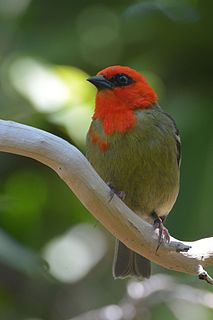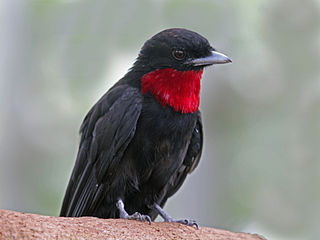
The International Union for Conservation of Nature is an international organization working in the field of nature conservation and sustainable use of natural resources. It is involved in data gathering and analysis, research, field projects, advocacy, and education. IUCN's mission is to "influence, encourage and assist societies throughout the world to conserve nature and to ensure that any use of natural resources is equitable and ecologically sustainable".

The American bittern is a species of wading bird in the heron family of the Pelican order of bird. It has a Nearctic distribution, breeding in Canada and the northern and central parts of the United States, and wintering in the U.S. Gulf Coast states, all of Florida into the Everglades, the Caribbean islands and parts of Central America.

Habitat conservation is a management practice that seeks to conserve, protect and restore habitat areas for wild plants and animals, especially conservation reliant species, and prevent their extinction, fragmentation or reduction in range. It is a priority of many groups that cannot be easily characterized in terms of any one ideology.

National Wildlife RefugeSystem is a designation for certain protected areas of the United States managed by the United States Fish and Wildlife Service. The National Wildlife Refuge System is the system of public lands and waters set aside to conserve America's fish, wildlife, and plants. Since President Theodore Roosevelt designated Florida's Pelican Island National Wildlife Refuge as the first wildlife refuge in 1903, the system has grown to over 562 national wildlife refuges and 38 wetland management districts encompassing more than 150,000,000 acres (607,028 km2).

The yellow-billed cuckoo is a cuckoo. Common folk-names for this bird in the southern United States are rain crow and storm crow. These likely refer to the bird's habit of calling on hot days, often presaging rain or thunderstorms.

The NatureServe conservation status system, maintained and presented by NatureServe in cooperation with the Natural Heritage Network, was developed in the United States in the 1980s by The Nature Conservancy (TNC) as a means for ranking or categorizing the relative imperilment of species of plants, animals, or other organisms, as well as natural ecological communities, on the global, national and/or subnational levels. These designations are also referred to as NatureServe ranks, NatureServe statuses, or Natural Heritage ranks. While the Nature Conservancy is no longer substantially involved in the maintenance of these ranks, the name TNC ranks is still sometimes encountered for them.

The conservation status of a group of organisms indicates whether the group still exists and how likely the group is to become extinct in the near future. Many factors are taken into account when assessing conservation status: not simply the number of individuals remaining, but the overall increase or decrease in the population over time, breeding success rates, and known threats. Various systems of conservation status exist and are in use at international, multi-country, national and local levels as well as for consumer use.

The Mauritius fody is a rare species of bird in the weaver family. It is endemic to the island of Mauritius. It is classified by BirdLife International as being endangered. It is also on the United States' Endangered Species List with an endangered status.

The Emergency Wetlands Resources Act of 1986 became a United States federal law (P.L.) 99-645 on November 10, 1986. Prior to the Act the purchase of wetlands by the Federal Government had been prohibited. The Act allocated funds from the Land and Water Conservation Fund (LWCF) for the purchase of wetlands by the Secretary of Interior, who is head of the United States Department of the Interior. The Act also instituted a National Wetlands Priority Conservation Plan which was to be established and set up by the Secretary. Included in this plan was a requirement for all States to include wetlands as part of their Comprehensive Outdoors Recreation plan. The plan also transferred the Migratory Bird Conservation Fund amounts which were to be equal to the import duties on arms and ammunition. The main purpose of the Act was to ensure a follow through on international obligations and fulfillment of these obligations on the various past and future migratory bird treaties. It also promoted the conservation of wetlands so the benefits they provide could be maintained.

In the United Kingdom hunting without qualification generally refers to hunting with hounds—normally fox hunting, beagling, stag (deer) hunting or minkhunting—whereas shooting is the shooting of game birds. What is called deer hunting elsewhere is deer stalking.

The red-tailed amazon, also known as the red-tailed parrot, is a species of parrot in the family Psittacidae. It is endemic to coastal regions in the south-east Brazilian states of São Paulo and Paraná. The bird has been threatened by habitat loss and capture for the wild bird trade, and is a symbol of the efforts to conserve one of the Earth's most biologically diverse ecosystems. Consequently, it is considered Near Threatened by BirdLife International and the IUCN. In 1991-92, the population had fallen below 2000 individuals. Following on-going conservation efforts, a count and estimate from 2015 suggests a population of 9,000–10,000, indicating that this species is recovering from earlier persecution. A recent study shows that the population of this species is stable at Paraná state, Southern Brazil, revealing population trend fluctuation during the last 12 years.

The chestnut-capped blackbird is a species of bird in the family Icteridae. It is found in Argentina, Bolivia, Brazil, French Guiana, Paraguay, and Uruguay, where its natural habitats are swamps, ricefields and pastureland. The International Union for Conservation of Nature rates its conservation status as "least concern".

The red pileated finch, also known as the red-crested finch, is a species of bird in the family Thraupidae. It is found in Argentina, Bolivia, Brazil, Ecuador, French Guiana, Guyana, Paraguay, Peru, on the eastern side of the Andes. Its natural habitats are subtropical or tropical dry forests, subtropical or tropical moist lowland forests, subtropical or tropical dry shrubland, and heavily degraded former forest. This is a common species, and the International Union for Conservation of Nature has rated its conservation status as "least concern".

The Pacific antwren, or Pacific streaked antwren, is a species of bird in the family Thamnophilidae. It is found in Colombia, Ecuador and Panama, living in forests, clearings, woodland verges and gardens.

The barred fruiteater is a species of bird in the family Cotingidae, found in Bolivia, Colombia, Ecuador, Peru, and Venezuela. Its natural habitat is subtropical or tropical moist montane forests. The population is stable, and they are considered common.

The purple-throated fruitcrow is a species of bird in the family Cotingidae, the cotingas. It is the only species of the genus Querula. It is native to Nicaragua, Costa Rica and Panama and most of the northern half of South America, its habitat being humid lowland forest where it feeds mainly on insects and fruit. It is a glossy black, medium-sized bird and the male has a purple-red throat patch. It nests in close vicinity with other birds of its species. Its population is in decline, but it is a common species with a very wide range, and the International Union for Conservation of Nature has assessed its conservation status as being of "least concern".

An endangered species is a species which has been categorized as very likely to become extinct. Endangered (EN), as categorized by the International Union for Conservation of Nature (IUCN) Red List, is the second most severe conservation status for wild populations in the IUCN's schema after Critically Endangered (CR).

Teatown Lake Reservation is a nonprofit nature preserve and environmental education center in Westchester County, New York, in the United States. The reservation includes an 1,000-acre (4.0 km2) nature preserve and education center located in the Westchester towns of Yorktown, Cortlandt, and New Castle. About 25,000 people come each year to hike the preserve's 15 miles (24 km) of trails, attend an education program, visit the Nature Center, or tour "Wildflower Island". Teatown's educators offer adult, family and children's programs to 20,000 participants annually, including nearly 6,000 schoolchildren and 700 summer camp students.
The Intermountain West Joint Venture (IWJV) is a partnership of government agencies, nongovernmental organizations, and other public and private landowners for the conservation of bird habitats in the inter-mountain areas of the western United States. It was established in 1994 and focuses on the "implementation of the conservation goals and objectives of five major bird initiatives": North American Waterfowl Management Plan, Partners in Flight, United States Shorebird Conservation Plan, North American Waterbird Conservation Plan and the National Sage Grouse Conservation Planning Framework. Its primary objective is to address conservation issues for about 40 waterbird species which use the marshes, playas, riparian zones, lakes and other wetlands throughout its extent.
The Walter's duiker is a species of duiker found in Togo, Benin and Nigeria. It was described in 2010. Its name commemorates Professor Walter Verheyen, who was the first to obtain a specimen of this species of duiker from Togo in 1968.



















